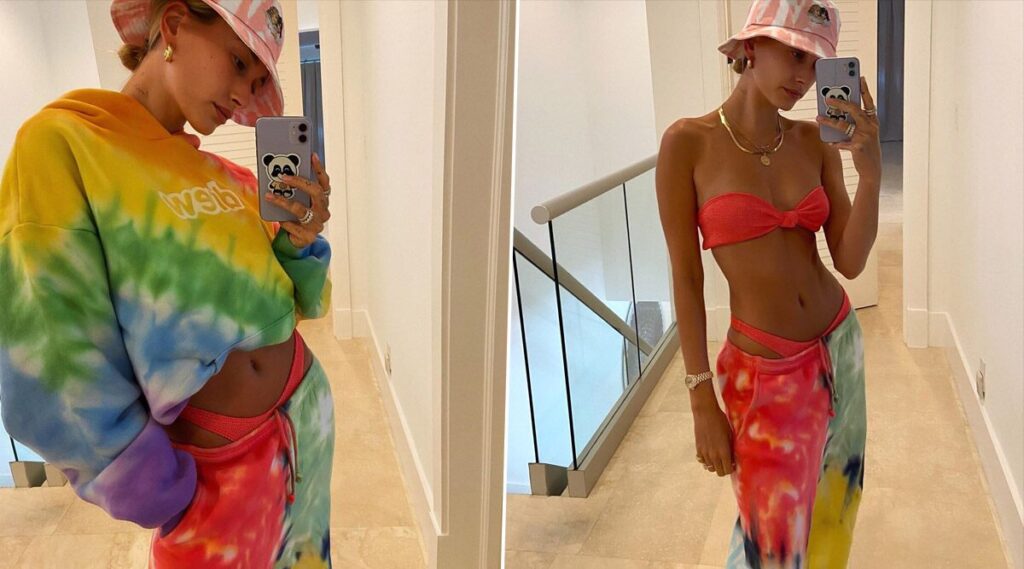Tie-dye is back again, but this time without the quintessential flower crown and hippie sunglasses. Utterly bored from laying on the couch and binge watching anything decent, many people decided to try at-home tie-dying during the COVID-19 lockdown. Numerous TikTok users showed off their homemade, tie-dyed creations and, just like that, the 2020 DIY tie-dye trend spread like wildfire. This trademark ‘60s hippie look has now become a huge trend on social media and on the runway in the past year.
Believe it or not, this DIY movement actually has ancient beginnings.
While tie-dye rose to popularity in America in the 1960s, the craft has been around for thousands of years. Ancient Asia is credited for having the earliest written records of tie-dye dating as far back as the 3rd century. Back then, people used natural dyes to color their clothing, but 6th century India is where the tie-dye technique we know and love today is believed to have gotten its start. This is when people began sectioning off small pieces of fabric to create unique designs on their clothing. However, there are various tie-dye techniques used in past centuries that all stemmed from different parts of the world including India, Peru, Africa, Indonesia, China, Japan, and, eventually, the United States.
Tie-dye was first introduced in America in 1909 by Columbia University professor Charles E. Pellow, and in the 1920s many Americans utilized tie-dye as a cheap way to decorate their homes and clothing during the Great Depression. However, it wasn’t until the ‘60s “hippie era” when tie-dye propelled into the mainstream. Tie-dye captured the zeitgeist of the times as hippies were fighting for civil rights and against the Vietnam war. The vibrant patterns “became a symbol of psychedelia, foregrounding a homemade aesthetic that became a kind of anti-fashion fashion,” said Amber Butchart, fashion historian, in a 2020 Oprah Daily article about tie-dye. Now, looking at the political unrest of 2020, it is easy to see why tie-dye spiked in popularity as people were seeking a peace symbol during the pandemic, the Black Lives Matter movement and the divisive presidential election.
Woodstock, the iconic musical festival of 1969, was described as “an Aquarian Exposition: 3 Days of Peace & Music” where half a million people gathered to escape from political conflicts surrounding the Vietnam War and civil rights. Countless attendees and musicians sported tie-dye as a symbol of peace including Janis Joplin, John Sebastian and Joe Cocker who all performed at Woodstock during the height of their careers and were known for wearing, as well as dying, their own clothing.



But tie-dye “continued to live on the fringes of the 1970s disco era, and rose again in the 1980s and ’90s as a colorful and bold style that teens gravitated toward,” according to a 2020 CR Fashion Book article about tie-dye.
Forever coined as the identifier of the hippies, tie-dye has gone in and out of style every few years. But, because tie-dye can be done at home, 2020 was perfect for it to surge in popularity once again. Those in quarantine were able to create their own fashions to resemble what they were seeing on celebrities’ social media. Many celebrities posted in their tie-dye sweat sets including musician and actress, Jennifer Lopez; model, Hailey Bieber; and, TikToker, Addison Rae which helped relaunch this trend.

“One of the nice things about quarantine is that everything [celebrities are] wearing is now accessible, because for once, they’re not at fancy fashion parties. They’re home, just like us,” said Lilliana Vazquez, Style expert and E! News host in the Oprah Daily article. “I remember thinking, maybe I can’t buy those $400 sweats, but I can figure out a way to make that.”
Most recently, tie-dye is making its debut as a main trend on the runway. The Alice+Olivia Spring 2021 RTW collection featured dozens of tie-dye pieces, but they weren’t the first designer to recently adopt this trend. Versace and Dior’s Spring/Summer 2020 and Stella McCartney’s and Prada’s Spring/Summer 2019 collections all highlighted tie-dye as a major trend for the upcoming years.

These powerhouse designers resurrected tie-dye, compared to the ‘60s when fashion designers chose not to adopt the trend as it was seen as a trend of the people, not something to capitalize on.
It’s undeniable that tie-dye has been in everyone’s closet recently, and it looks like the 2020 fashion trend might be here to stay. Made for you, or do-it-yourself, there are endless ways to wear groovy tie-dye patterns in 2021 and going into 2022.





